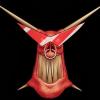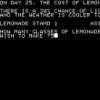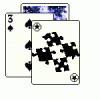Hello all,
I'm currently creating a game and I have trouble about the combat system. I made a google presentation, exposing what is my game, and some gameplay mechanics. You can find it here. Edit : (If you want to go directly to the second version, go there)
In this presentation you won't find other mechanics than the combat related one. The reason is that of this part I am the most unsure, and it is also one of the main feature of the game.
That's why I'll appreciate any feedback, thoughts, remark or advice with a glad ear.
I also would like to know what you think about this format of presentation, is it clear enough? Or is a plain text documentation better?
There should be enough informations on these slides to understand the mechanics, but if you have any question, or you want to know more, don’t hesitate to contact me (on this post, or by pm)
Thanks a lot,
Navezof
[Looking for feedback] RPG combat system
The first thing I need to say is that I *Loved* the little drawings of Magic Girl and The Goon. Something about them just made me smile. Such a fun way to do easy but impactful art in a presentation.
I feel like I get what you are going for with this combat system, but I disliked how the fight scene was broken up by those slides of text. To improve your presentation, I would avoid the jarring visual of popping from the combat picture to just full screen text and back again.
Personally, I'm not sold on the word "Job" as a descriptor. To most native English speakers, the word job is often used to denote a task or profession. It seems from this cursory introduction that you are using it to almost describe an equipment loadout.
I'm a little unsure about the Combos and I got distracted with you said "OnFire is triggered" and I was all "Are we talking scripting now?" becasue it looked like C#.
I need more info on the mechanics of this:
Low stance < Medium stance < High stance < Low stance
To me, this seems like a fun little combat system. I can't make any real in-depth comments until I've either played it or seen some testing in something like Machinations, but I certainly feel you are on the right track with this. I would like to see more information on the opposed test formula you are using.
Indie games are what indie movies were in the early 90s -- half-baked, poorly executed wastes of time that will quickly fall out of fashion. Now go make Minecraft with wizards and watch the dozen or so remakes of Reservior Dogs.
When I clicked the link and found a slide presentation my first reaction was to just close it and not bother replying. But on a second thought I went through it all and actually I thought that it was a pretty effective way to illustrate the situation you want to discuss.
Since it sounds like you want to maintain the fast paced action of a tournament fighter style of game, I think you need to rethink the action points a little. I think what you're really after here is more like manna (or some other name that fits the generic purpose, it's just the most appropriate word I could think of just now) where the player or enemy is able to initiate something special within the combat. When manna is low then characters can resort to more common physical attacks.
I also don't think you need as many things on the screen as you think. A bar for health, one for manna (or whatever you call it) and you're good to go. The current costume you have and should be evident by the appearance of the character on the screen. You could also argue that you don't really need to know your enemy's current stats unless you really want to let the player be warned about what he's facing.
The part that would most likely trip me up would be using the controls sufficiently to switch between costumes and stances while attacking or defending. I would want, ideally, to have some sort of safe place to be able to practice my skills just working with the controller.
Of course, the best way to know for sure how well any of these things will work is to get a prototype going.
The first thing I need to say is that I *Loved* the little drawings of Magic Girl and The Goon. Something about them just made me smile. Such a fun way to do easy but impactful art in a presentation.
Then the first thing I will say is thanks!
I feel like I get what you are going for with this combat system, but I disliked how the fight scene was broken up by those slides of text. To improve your presentation, I would avoid the jarring visual of popping from the combat picture to just full screen text and back again.
I wanted to do something like : exemple then explaination. But it's trye that it is breaking the "flow" of the presentation. So I made a second version, with some corrections. (spelling, better flow, more explaination and better drawing ^^)
Personally, I'm not sold on the word "Job" as a descriptor. To most native English speakers, the word job is often used to denote a task or profession. It seems from this cursory introduction that you are using it to almost describe an equipment loadout.
Changed to Costume (to keep the magical stuff going ![]() )
)
I'm a little unsure about the Combos and I got distracted with you said "OnFire is triggered" and I was all "Are we talking scripting now?" becasue it looked like C#.
Ah, Unity stuff. I also changed the name of the combo.
The combo mechanism is rather simple. A character may learn combo spells. These spells will be automaticaly casted if the right conditions are met. For example, in my presentation the combo True Fire is triggered if three medium type spells are casted. Once casted, the combo spell will behave like any other spell. In this case he will add a spell reduction cost bonus.
I need more info on the mechanics of this:
Low stance < Medium stance < High stance < Low stance
This is one of the base mechanism of the gameplay, and nearly everything use this mechanic. It's like rock, paper, scissors, or the elements in Pokemon. Except it is apply to spells, guardes, enemy. A spell will be more effective against a guarde (more likely to break the guarde) and an enemy (deal more damage)
That's why you have to pay attention to the type of your enemy, his guarde and spells in order to chose the best spells and guarde to counter him.
I would like to see more information on the opposed test formula you are using
Character have three stats : Attack, Defense an Damage.
Spell have two stats : Attack and Damage
Guarde have one stats : Defense
If the enemy has a guarde up, there is an opposing test to know if the spell break the guarde or not. I do a simple comparison :
Is (Character's Attack + Spell's Attack) superior to (Defender's Defense + Guarde's Defense) ?
If yes then, the defender's guarde break.
I wanted to stay as simple as possible. At least from now.
And here is the link to the presentation v2
When I clicked the link and found a slide presentation my first reaction was to just close it and not bother replying. But on a second thought I went through it all and actually I thought that it was a pretty effective way to illustrate the situation you want to discuss.
Then thanks for staying with me ^^'
Since it sounds like you want to maintain the fast paced action of a tournament fighter style of game, I think you need to rethink the action points a little. I think what you're really after here is more like manna (or some other name that fits the generic purpose, it's just the most appropriate word I could think of just now) where the player or enemy is able to initiate something special within the combat. When manna is low then characters can resort to more common physical attacks.
I didn't plan to allow the player to move during the fight. He could cast offensive and defensive spells and change costume. If the player doesn't have anymore mana, then he can't do anything. I counted on a rather high AP recovery rate (one second at most) to avoid this kind of situation too often. But, if the number of action per minutes should be quite hight. It should never reach the level of a fighting game.
As of now, my game as I designed it should be around 80% rpg and 20% fighting.
Even thoug lately I've been thinking a lot about making it more fighting and less rpging. For exemple, the possibility to have a "special" bar, which fill up when you attack, or defend and when full you can cast a "super" version of a spell or equip a "super" version of one of your costume for a limited amount of time. Or giving to the player the ability to dodge incoming attack by pressing the right button at the right moment. But I'm still wondering if should implement those or not.
I also don't think you need as many things on the screen as you think. A bar for health, one for manna (or whatever you call it) and you're good to go. The current costume you have and should be evident by the appearance of the character on the screen. You could also argue that you don't really need to know your enemy's current stats unless you really want to let the player be warned about what he's facing.
It depends on how many rpg and fighting I put in the game. The enemy's stats are maybe not required, but your stats and the spells description (cost, type, effect) are more needed. Especially if you change costume often. And as each costume may have completely different spells it is maybe more pratical to always have those kind of informations.
The part that would most likely trip me up would be using the controls sufficiently to switch between costumes and stances while attacking or defending. I would want, ideally, to have some sort of safe place to be able to practice my skills just working with the controller.
This is the intent. Some combos will automatically change your costume (for free!) and other will automaticaly cast spells for free, so you should be able to something like :
Fireball > Fireball > free Fire Tempest > free change costume to water mage > ice spear > ice sword > free ice wall > taunt
Here you have 3 combos :
- Fireball > Fireball = Fire Tempest
- Fireball > Fireball > Fire Tempest = change costume to water mage
- Ice spear > Ice sword = Ice wall
Of course, the best way to know for sure how well any of these things will work is to get a prototype going.
A basic one should be done for tomorrow. And yes, without a viable prototype I don't think I will be able to figure things out ^^'
This is one of the base mechanism of the gameplay, and nearly everything use this mechanic. It's like rock, paper, scissors, or the elements in Pokemon. Except it is apply to spells, guardes, enemy. A spell will be more effective against a guarde (more likely to break the guarde) and an enemy (deal more damage)
Yes, I get it's rochambeau nature. I just don't understand what it means. Is high to low the level of preparedness? The level of speed? A literal level of vertical position? It applies to so many things (spells, enemies, etc.) that it seems somewhat vague.
Also I wanted to add... why not French this thing up a bit? I know you are based in France, so why not call these things something fitting for your Parisian location?
Indie games are what indie movies were in the early 90s -- half-baked, poorly executed wastes of time that will quickly fall out of fashion. Now go make Minecraft with wizards and watch the dozen or so remakes of Reservior Dogs.
Yes, I get it's rochambeau nature.
Rochambeau nature? What do you mean? (I know rochambeau, but in this context I don't understand ^^')
I just don't understand what it means. Is high to low the level of preparedness? The level of speed? A literal level of vertical position? It applies to so many things (spells, enemies, etc.) that it seems somewhat vague.
The type is the nature, the element, the category of the spell/guarde/costume/enemy. For exemple you could have :
The high type is a type which favors aggressiveness (the attack stat) and is associated with fire.
random example of : spell = Fireball, guarde = FireWall, enemy = Firefox, costume = Pyromancer
The medium type is a type which favors defensiveness (the defense stat) and is associated with ground.
random example of : spell = earthquake, guarde = Stoneflesh, enemy = goblins, costume = Monk
The low type is a type which favors power (the damage stat) and is associated with water.
random example of : spell = ice spear, guarde = Waterdance, enemy = frogs, costume = Pirate
In term of gameplay it doesn't mean anything else. I hope I answered your question, and if I'm not clear enough don't hesitate to ask me again.
Also I wanted to add... why not French this thing up a bit? I know you are based in France, so why not call these things something fitting for your Parisian location?
I'm not really chauvinism but I thought about that, a lot. The story will take place in the ruins and underground of Paris. But for now as I'm still in the very start of the development, I just picked the first names I got ^^'
Rochambeau nature? What do you mean?
I meant that I understood the rock-paper-scissor mechanism (the rochambeau-ness), I just don't know why you called it what you called it. I think calling them Aggressive, Defensive, and Power stances is more meaningful and obvious. Why you wanna make me work to learn vague terms? ![]()
French that thing up, man! Puissance Stance! Give it some flavor! Fallout 1-2 were fun because they used the trappings of 1950's American modernism. Go wild with this thing... it's about magic girls!
Indie games are what indie movies were in the early 90s -- half-baked, poorly executed wastes of time that will quickly fall out of fashion. Now go make Minecraft with wizards and watch the dozen or so remakes of Reservior Dogs.
I meant that I understood the rock-paper-scissor mechanism (the rochambeau-ness), I just don't know why you called it what you called it. I think calling them Aggressive, Defensive, and Power stances is more meaningful and obvious. Why you wanna make me work to learn vague terms?
At first I wanted to go with medieval fencing terms or something alike, with high and low guard (medium guard doesn't seems to exist ^^') I think I should find something else better fitting. But for now it is not really my priority :)
French that thing up, man! Puissance Stance! Give it some flavor! Fallout 1-2 were fun because they used the trappings of 1950's American modernism. Go wild with this thing... it's about magic girls!
True. Having a setting based on a real place/time can often bring a more coherent and interesting experience. But if it's not carefully made, it can be just ridiculous. For exemple, too much stereotype or over-used place. Eiffel tower, how many time have you been destroyed by aliens/mad scientist/cataclysm? :)
Eiffel tower, how many time have you been destroyed by aliens/mad scientist/cataclysm?
That beast is long gone. Maybe you could show how industrious Parisians used the metal to build useful things! ![]()
Indie games are what indie movies were in the early 90s -- half-baked, poorly executed wastes of time that will quickly fall out of fashion. Now go make Minecraft with wizards and watch the dozen or so remakes of Reservior Dogs.







